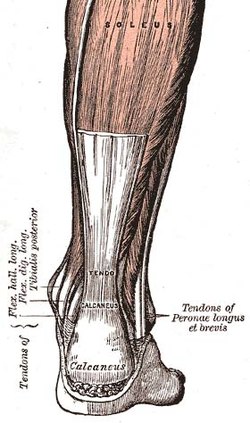Tendinopathy

Editor-In-Chief: Prab R Tumpati, MD
Obesity, Sleep & Internal medicine
Founder, WikiMD Wellnesspedia &
W8MD medical weight loss NYC and sleep center NYC
| Tendinopathy | |
|---|---|

| |
| Synonyms | Tendinosis, tendinitis, tendonitis |
| Pronounce | N/A |
| Specialty | N/A |
| Symptoms | Pain, swelling, impaired function |
| Complications | Rupture of the tendon |
| Onset | Gradual |
| Duration | Weeks to months |
| Types | N/A |
| Causes | Overuse, injury, age-related degeneration |
| Risks | Repetitive strain, age, obesity, diabetes |
| Diagnosis | Physical examination, ultrasound, MRI |
| Differential diagnosis | Bursitis, arthritis, nerve entrapment |
| Prevention | Proper warm-up, stretching, avoiding overuse |
| Treatment | Rest, physical therapy, NSAIDs, corticosteroid injections |
| Medication | NSAIDs |
| Prognosis | Generally good with treatment |
| Frequency | Common |
| Deaths | N/A |

Surgical scissors are a type of surgical instrument specifically designed to cut through body tissues. They come in a variety of shapes and sizes, and are used in a wide range of surgical procedures.
History[edit]
The use of surgical scissors dates back to ancient times. The ancient Egyptians and ancient Romans both used similar instruments in their surgical procedures. The design and functionality of surgical scissors have evolved over the centuries, with modern versions being made from high-quality stainless steel and featuring a variety of blade types and handle designs.
Types of Surgical Scissors[edit]
There are several types of surgical scissors, each designed for specific surgical tasks. These include:
- Metzenbaum Scissors: These are thin, light scissors used for cutting delicate tissues. They have a long shank and a relatively small blade.
- Mayo Scissors: These are heavy, sturdy scissors used for cutting tough tissues such as fascia and muscle. They come in both straight and curved versions.
- Iris Scissors: These are small, delicate scissors used for fine, precise cutting in ophthalmic and microsurgical procedures.
- Tenotomy Scissors: These are small, sharp scissors used for cutting tendons in orthopedic and ophthalmic surgery.
Use in Surgery[edit]
Surgical scissors are used in a variety of surgical procedures. They are used to cut through tissues, to dissect tissues, and to remove tissues. The type of scissors used depends on the specific procedure and the type of tissue being cut.
Care and Maintenance[edit]
Surgical scissors, like all surgical instruments, require proper care and maintenance to ensure their longevity and effectiveness. This includes regular cleaning, sterilization, and sharpening.
See Also[edit]
Ad. Transform your life with W8MD's Budget GLP-1 injections from $75


W8MD offers a medical weight loss program to lose weight in Philadelphia. Our physician-supervised medical weight loss provides:
- Weight loss injections in NYC (generic and brand names):
- Zepbound / Mounjaro, Wegovy / Ozempic, Saxenda
- Most insurances accepted or discounted self-pay rates. We will obtain insurance prior authorizations if needed.
- Generic GLP1 weight loss injections from $75 for the starting dose.
- Also offer prescription weight loss medications including Phentermine, Qsymia, Diethylpropion, Contrave etc.
NYC weight loss doctor appointmentsNYC weight loss doctor appointments
Start your NYC weight loss journey today at our NYC medical weight loss and Philadelphia medical weight loss clinics.
- Call 718-946-5500 to lose weight in NYC or for medical weight loss in Philadelphia 215-676-2334.
- Tags:NYC medical weight loss, Philadelphia lose weight Zepbound NYC, Budget GLP1 weight loss injections, Wegovy Philadelphia, Wegovy NYC, Philadelphia medical weight loss, Brookly weight loss and Wegovy NYC
|
WikiMD's Wellness Encyclopedia |
| Let Food Be Thy Medicine Medicine Thy Food - Hippocrates |
Medical Disclaimer: WikiMD is not a substitute for professional medical advice. The information on WikiMD is provided as an information resource only, may be incorrect, outdated or misleading, and is not to be used or relied on for any diagnostic or treatment purposes. Please consult your health care provider before making any healthcare decisions or for guidance about a specific medical condition. WikiMD expressly disclaims responsibility, and shall have no liability, for any damages, loss, injury, or liability whatsoever suffered as a result of your reliance on the information contained in this site. By visiting this site you agree to the foregoing terms and conditions, which may from time to time be changed or supplemented by WikiMD. If you do not agree to the foregoing terms and conditions, you should not enter or use this site. See full disclaimer.
Credits:Most images are courtesy of Wikimedia commons, and templates, categories Wikipedia, licensed under CC BY SA or similar.
Translate this page: - East Asian
中文,
日本,
한국어,
South Asian
हिन्दी,
தமிழ்,
తెలుగు,
Urdu,
ಕನ್ನಡ,
Southeast Asian
Indonesian,
Vietnamese,
Thai,
မြန်မာဘာသာ,
বাংলা
European
español,
Deutsch,
français,
Greek,
português do Brasil,
polski,
română,
русский,
Nederlands,
norsk,
svenska,
suomi,
Italian
Middle Eastern & African
عربى,
Turkish,
Persian,
Hebrew,
Afrikaans,
isiZulu,
Kiswahili,
Other
Bulgarian,
Hungarian,
Czech,
Swedish,
മലയാളം,
मराठी,
ਪੰਜਾਬੀ,
ગુજરાતી,
Portuguese,
Ukrainian


